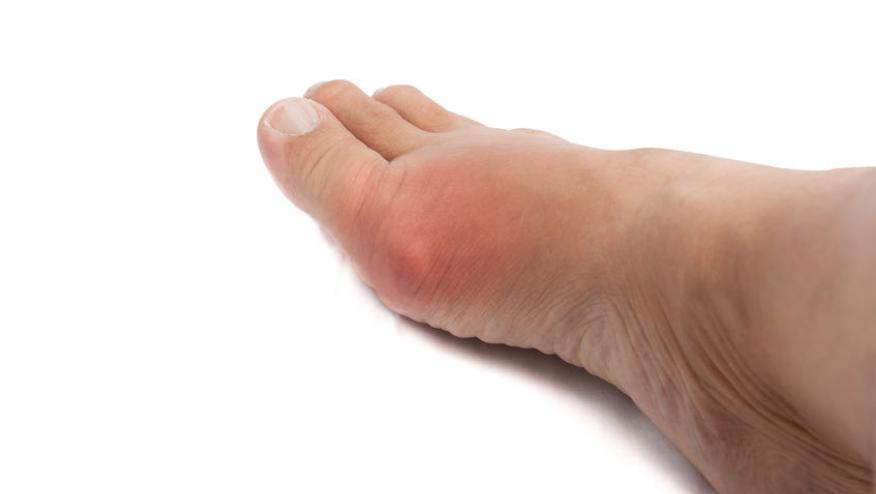U.S. Gout Rates Remain Steady, but Substantial Save

Using data from 5,467 adults in the US in the National Health and Nutrition Examination Survey (NHANES) for the years 2007-2016, researchers found that the prevalence of gout and hyperuricemia has remained at 3.9%, having doubled from the 1960s to the 1990s, corresponding to an estimated 9.2 million adults with gout in 2015-2016.
However, treatment rates also remained the same during the years 2007-2016, so only about one-third of patients are receiving ULT, according to Hyon K. Choi, MD, DPH, of Harvard Medical School and Massachusetts General Hospital in Boston, and colleagues who reported their findings online in Arthritis & Rheumatology.
Gout is a form of inflammatory arthritis that is curable. NHANES is a nationally representative sample of U.S. men and women.
Choi and colleagues noted that the current stability of gout and hyperuricemia may be related to plateauing trends of chronic kidney disease (CKD) and hypertension in the U.S. over the same period, given their strong association with gout and hyperuricemia.
Previous analyses of NHANES data had tracked the rising rates of gout and hyperuricemia in earlier decades, but it was not clear whether these trends and related risk factors had continued since the late 1990s. Choi and colleagues analyzed the five most recent NHANES cycles (2007-2008, 2009-2010, 2011-2012, 2013-2014, and 2015-2016), which included 14,161 men and 15,040 women ages ≥20 years.
In the 2015-2016 cycle, the mean age was 48, slightly fewer than half of participants were men, and two-thirds were non-Hispanic whites. The prevalence of gout was 5.2% for men and 2.7% for women, with highest rates being seen among those ages ≥80.
During that cycle, hyperuricemia using the standard definition was 20.2% among men and 20% among women. Using the 7 mg/dL cutoff, the rates were 20.2% for men and 4.2% for women, while for the 6 mg/dL cutoff, the rates were 49.5% and 16.4%, respectively.
Hyperuricemia was defined as a level of serum urate >7 mg/dL for men and >5.7 mg/dL for women. Alternative definitions included levels >6 mg/dL, which is the standard target for gout treatment, and >7 mg/dL, which represents the supersaturation point of serum urate.
The overall mean serum urate level was 5.39 mg/dL (95% CI 5.34-5.45), while mean levels were 6.04 mg/dL and 4.79 mg/dL for men and women, respectively.
During the years 2007-2014 (the latest year with available data), the prevalence of ULT use was 32.8%, with allopurinol representing 95% of prescriptions.
Among individuals with gout, factors associated with a greater likelihood of use of ULT were male sex, stage 3 CKD, and obesity.
Also during the years 2007-2014, the prevalence of patients achieving the target serum urate level <6 mg/dL was 37.7% (95% CI 34-41.6). For men, the prevalence was 31.6% (95% CI 27.1-36.4), while for women, it was 51.8% (95% CI 43.3-60.2).
Factors associated with a more than 50% lower odds for reaching the target urate level included male sex, CKD stage ≥3 or higher, obesity, and use of thiazide diuretics. "Given the well established role of serum urate levels for gout flares, these data suggest a potential need for more aggressive therapy among these subgroups," the researchers observed.
Mean serum urate levels were 5.78 mg/dL for patients on ULT compared with 6.92 mg/dL for those not on therapy. After adjustment for multiple factors including age, sex, BMI, blood pressure, glomerular filtration rate, use of thiazide diuretics, and alcohol intake, those on ULT had a serum urate level 1.40 mg/dL lower than those not on treatment.
Patients with gout receiving ULT were more than six times more likely to achieve the target urate level <6 mg/dL than nonusers (OR 6.21, 95% CI 3.93-9.81).
The steady rates of gout in the U.S. contrast with reports from other countries, indicating rising trends during the same period in New Zealand, Canada, the U.K., and Korea. The rates, however, still remain lower than the most recent U.S. estimate, "likely reflecting the obesity epidemic" in the U.S., as well as differences in diet and lifestyle factors, the authors stated.
Regarding the persistently low rates of the use of ULT for patients with gout, researchers pointed out barriers, including patient and provider knowledge gaps, and inadequate recognition that the disorder is now considered curable. Moreover, it is not yet apparent whether the use of ULT will decline further following recent gout care guidelines from the American College of Physicians that do not recommend a ULT approach to treat-to-target approach for serum urate, unlike guidelines from the American College of Rheumatology and the European League Against Rheumatism guidelines, researchers stated.
Study strengths included the nationally representative sample of U.S. men and women, making it generalizable to the U.S. population, and its use of sex-specific definitions of hyperuricemia. A limitation was the use of self-reporting for gout, making it possible that its estimation of gout prevalence "is likely inflated."
Also given the fact that patients are often non-compliant with ULT and/or may discontinue its use for extended periods, the data may underestimate the overall history of ULT use, researchers noted. A 10-year period (2007-2016) may not have been long enough to detect a significant trend over a longer period, they added. Future analyses should be done to assess trends of gout and hyperuricemia over a longer period of time, they recommended.










If you are a health practitioner, you may Login/Register to comment.
Due to the nature of these comment forums, only health practitioners are allowed to comment at this time.